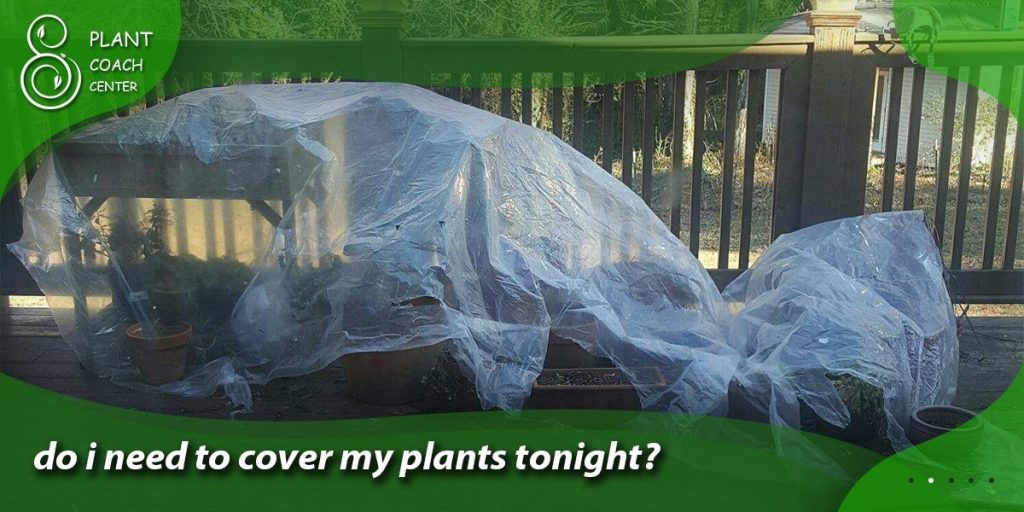When Should I Cover My Plants?
Welcome to the world of plant care, where nature’s delicate dance meets human nurturing. As seasons transition and temperatures fluctuate, the well-being of our beloved green companions takes center stage. “When Should I Cover My Plants” unveils the art and science of safeguarding your botanical treasures from the capricious whims of weather.
Whether you’re a seasoned gardener or a novice plant parent, understanding the optimal times to employ protective covers can spell the difference between vibrant flourishing and potential distress. From the ethereal touch of frost on a crisp morning to the relentless downpours of rain and the scorching embrace of the sun’s rays, this article embarks on a journey through the pivotal moments that call for your plants to be cocooned in shelter.
Join us as we delve into the subtleties of temperature shifts, weather forecasts, and the unique requirements of diverse plant stages, guiding you toward becoming a guardian of growth and vitality.

Understanding Frost and Cold Spells
In the enchanting world of plants, the arrival of frost and sudden cold spells can send shivers down even the most seasoned gardener’s spine. Frost occurs when the temperature drops below freezing, causing ice crystals to form on plant surfaces.
This seemingly harmless phenomenon can devastate your green companions, as ice crystals damage cell walls, leading to cell rupture and dehydration. Understanding the nuances of frost and its various forms is essential to protecting your plants.
Cold spells, often accompanied by chilly winds, can catch you and your plants off guard. These spells bring about a rapid drop in temperature, potentially harming your plants before you even realize it’s happening. While some plants are hardier and more resilient to cold conditions, others, mainly tropical or subtropical varieties, are far more susceptible to frost’s icy touch.
To combat these cold adversaries, it’s crucial to be proactive. Keep an eye on weather forecasts, especially during transitional seasons like fall and spring, when temperature fluctuations are most unpredictable. A sudden late spring frost or an early fall freeze can particularly damage new growth. Use covers such as cloths, sheets, or frost blankets to shield your plants from frost’s grasp. These covers create a protective layer that traps heat from the ground, maintaining a slightly higher temperature around your plants and preventing frost formation.
As you venture further into plant care, remember that not all frost is the same. The type of frost—radiation, advection, or hoar frost—can impact how your plants respond and what protective measures you should take. In regions prone to ice, it’s wise to have a collection of covers ready to deploy immediately. By mastering the art of understanding frost and cold spells, you’re well on your way to becoming a guardian of your garden, ensuring that your plants thrive in the face of even the chilliest challenges nature throws.
Tailoring Covers for Spring, Fall, and Winter
As our wardrobe changes with the seasons, so should our approach to protecting our plants. Spring, fall, and winter each present unique challenges that demand tailored strategies for keeping your botanical companions safe and thriving. As the warmth of spring beckons new growth, unexpected late frosts can put tender shoots at risk. During this season, opt for lightweight covers that allow sunlight and air to reach your plants while providing a shield against sudden temperature drops.
In the crisp embrace of fall, the gradual cooling can lull gardeners and plants into a false sense of security. As temperatures dip, especially during the night, covers become a must. Utilize slightly heavier materials that offer better insulation, safeguarding your plants from potential frost damage. Remember that fall is also a time when strong winds and erratic weather patterns can wreak havoc on exposed plants, making the protection offered by covers even more crucial.
Winter, the harshest of seasons, demands the most robust defenses. As snow blankets the ground and icy winds howl, the focus shifts to preserving the health of your plant’s root systems. Insulating covers, such as burlap or specialized frost blankets, play a pivotal role in this endeavor. These covers trap heat near the ground, protecting roots from extreme cold. However, be cautious not to allow bodies to come into direct contact with foliage, which can lead to moisture buildup and disease.
Adapting your covering approach throughout the year ensures that your plants receive the precise care they require during changing conditions. Regularly monitor weather forecasts and be prepared to adjust your strategy accordingly. By customizing your covers for each season, you extend your plants’ growing season, enhance their resilience, and showcase your expertise as a mindful and responsive plant guardian.

Unveiling the Importance of Nocturnal Covers
When the sun dips below the horizon, and the world is dark, new challenges emerge for your plants. Nighttime covers become the unsung heroes in your garden’s defense against temperature drops and potential frost formation. While daytime temperatures may have been mild, the absence of sunlight can lead to rapid cooling, threatening your plants’ delicate equilibrium.
Nocturnal covers serve as a shield, trapping the day’s accumulated warmth around your plants and preventing heat escape into the cold night air. This additional insulation helps maintain a more stable temperature, reducing the risk of stress-induced damage. These covers are particularly beneficial during transitional seasons when temperature fluctuations between day and night are most drastic.
It’s essential to choose suitable material for your nighttime guardians. Opt for breathable fabrics that allow for adequate air circulation, preventing moisture buildup that can lead to fungal issues. Lightweight fabrics like row covers or specially designed frost cloths are excellent options, striking a balance between insulation and breathability.
Timing is everything when it comes to these nocturnal protectors. As the evening sets in and temperatures drop, gently drape the covers over your plants. Secure them with stakes or weights to prevent them from blowing away in the wind. Remove the daily masks to allow sunlight to reach your plants and facilitate photosynthesis.
By embracing the concept of nighttime guardians, you demonstrate a comprehensive understanding of your plants’ needs, showing that your care extends beyond the sunlit hours. Whether safeguarding young seedlings or shielding established plants from unexpected temperature dips, these covers are a testament to your dedication as a vigilant and thoughtful plant parent.

Shielding Plants from Harsh Weather Conditions
Mother Nature’s temperament can be as unpredictable as diverse, ranging from pouring rain to scorching sunshine and even bouts of hail. As caretakers of the green world, it’s essential to understand the role of covers in safeguarding your plants from these varying and often extreme weather conditions.
During heavy rainfall, covers serve as a barrier against excess moisture, leading to soil erosion, waterlogged roots, and the development of fungal diseases. Choose waterproof or water-resistant materials that can shed raindrops while still allowing for some airflow. Avoid tightly sealing the covers to prevent humidity buildup, which can foster fungal growth.
When the sun blazes with relentless intensity, covers become a shield against excessive UV exposure and heat stress. Shade cloth or light-colored covers can help diffuse sunlight, preventing scorching and reducing the risk of wilting. Additionally, these covers can provide a respite for plants sensitive to direct sunlight, such as certain herbs and delicate flowers.
In regions prone to hailstorms, covers become a literal armor against ice pellets that can shred leaves and damage delicate stems. Opt for sturdier materials that can absorb the impact of hail, providing a buffer between the harsh elements and your plants.
The versatility of covers shines in their ability to adapt to various weather scenarios. Be prepared to switch between different types of surfaces depending on the prevailing conditions. Regularly inspect your plants for signs of distress, such as waterlogged soil, wilting, or sunburn, and adjust your lids accordingly.
As you master the art of shielding your plants from the elements, you emerge as a weather warrior—a guardian who doesn’t shy away from nature’s whims but embraces them with tailored solutions. By harnessing the power of covers, you demonstrate a holistic commitment to your plants’ well-being, ensuring they flourish regardless of rain or shine.
Early Birds and Night Owls: Timing Your Covering Routine
Just as a symphony conductor sets the tempo for a performance, timing plays a crucial role in orchestrating the well-being of your plants through strategic cover usage. Whether it’s the dawn of a new day or the approach of twilight, knowing when to deploy and remove covers can significantly impact your plants’ resilience and growth.
Morning Vigilance
As the first rays of sunlight pierce the horizon, your plants awaken to a fresh day. During this time, removing covers is ideal to protect them from the chilly night. This lets your plants absorb the warming sunlight and kickstart their metabolic processes. Uncovering your plants early in the day promotes healthy growth and photosynthesis.
Evening Retreat
As the sun begins its descent, the temperatures start to drop, and your plants prepare for the cool embrace of night. This is the perfect moment to drape covers over them, creating a protective cocoon against potential nighttime temperature fluctuations and frost formation. Be sure to secure the lids to prevent them from being blown away by wind gusts.
Tender Transitions
Consider a more flexible covering routine in the transitional seasons of spring and fall when temperature changes can be abrupt. Uncover your plants in the morning, but watch weather forecasts. If an unexpected cold snap is predicted, cover your plants again in the late afternoon to shield them from the impending chill.
Stormy Scenarios
When adverse weather conditions are on the horizon, such as heavy rains or hailstorms, anticipate their arrival and cover your plants preemptively. This proactive approach shields your plants from potential damage, showcasing your dedication to their well-being.

Young Plants and Their Special Covering Needs
In the delicate ballet of nature, young plants take their first steps towards growth, vulnerability juxtaposed with the promise of vitality. These tender beginnings require extra care and attention, making their unique covering needs a critical consideration for any dedicated plant parent.
New Life, New Challenges
Young plants are more susceptible to fluctuations in temperature and environmental stressors. Their limited root systems and delicate foliage can quickly succumb to the harsh touch of frost or extreme weather conditions. As their guardian, it’s your responsibility to provide a nurturing shield that fosters their development.
Miniature Marvels
Seedlings and young plants have smaller bodies and thinner stems, making them more delicate than their mature counterparts. When covering these younglings, opt for lightweight materials that won’t exert excessive pressure on their fragile structures. Row covers or cloths designed explicitly for seedlings work well, offering protection without hindering growth.
Microclimates of Care
The area immediately surrounding young plants can become a microclimate of its own. When covering young plants, ensure the cover doesn’t come into direct contact with the foliage, as moisture accumulation can lead to mold and disease. Use stakes or supports to create a small sheltering space that allows air circulation while still providing protection.
The Dance of Gradual Unveiling
Young plants thrive on the energy provided by sunlight, but too much exposure too soon can shock their sensitive systems. Gradually acclimate them to outdoor conditions by uncovering them for short periods and increasing the exposure over time. This gradual unveiling ensures they develop the resilience to face the elements independently.
Tailoring to Tiny Needs
Different plant species and varieties have varying sensitivities and growth rates. Research the specific requirements of your young plants and tailor your covering approach accordingly. Some might need extended protection during their early stages, while others may be more resilient and require occasional covering.
Using Predictions to Plan Plant Covers
In plant care, knowledge is power, and the crystal ball we rely on is the weather forecast. The art of using weather predictions to preemptively plan your plant covers is a skill that can elevate your gardening game from reactive to proactive.
Weather as a Guide
Meteorological forecasts offer valuable insights into temperature fluctuations, precipitation, wind patterns, and potential frost. By watching these predictions, you can anticipate weather events that might harm your plants and take preemptive measures.
Proactive Protection
With a reliable forecast, you can strategically deploy covers to shield your plants before adverse weather strikes. If frost is expected, for example, you can drape your plants with frost blankets before nightfall to prevent damage. This proactive approach minimizes stress on your plants and reduces the need for last-minute interventions.
Fine-Tuning Your Strategy
Different weather conditions demand different levels of protection. Light rain might only require breathable covers that prevent waterlogging, while an impending hailstorm could necessitate sturdier materials to absorb impacts. You optimize your plants’ defense mechanisms by tailoring your surfaces based on the forecasted weather.
Timing Is Everything
Weather forecasts include crucial information such as temperature lows and highs for specific hours. Use this data to plan when to uncover your plants in the morning and when to shield them as the evening approaches. This rhythm ensures your plants receive the benefits of sunlight while being guarded from sudden temperature drops.
A Seasonal Symphony
Weather forecasts become even more indispensable during transitional seasons when conditions fluctuate dramatically. As spring unfurls its blossoms and autumn’s chill looms, you can fine-tune your covering routine to accommodate shifting weather patterns, protecting your plants through these dynamic periods.

Conclusion
As we bid farewell to this exploration of plant covers and their role as steadfast protectors, we find ourselves equipped with a newfound understanding of the delicate equilibrium between our plants and the ever-changing elements. From frost-kissed mornings to rain-soaked afternoons, the art of timing, tailored strategies, and vigilant weather-watching have emerged as our allies in nurturing vibrant gardens.
Whether you’re tending to young seedlings or established perennials, mastering plant covers leads us to a realm where care extends beyond daylight hours. With each cover thoughtfully draped, we step into the shoes of guardians who anticipate nature’s whims and respond with wisdom. So, let us embrace the nuanced choreography of gardening, where the website PlantCouchCenter.com stands as a trove of knowledge and a sanctuary for those who seek to harmonize nature’s capriciousness with the tender touch of human care.
When should I cover my plants during frost?
Cover plants before nightfall to protect them from frost's damaging effects.
How can I shield young plants from harsh weather?
Use lightweight covers tailored to their needs for insulation and protection.
Why is timing crucial in using plant covers?
Proper timing ensures optimal growth by shielding plants from extreme weather conditions.







